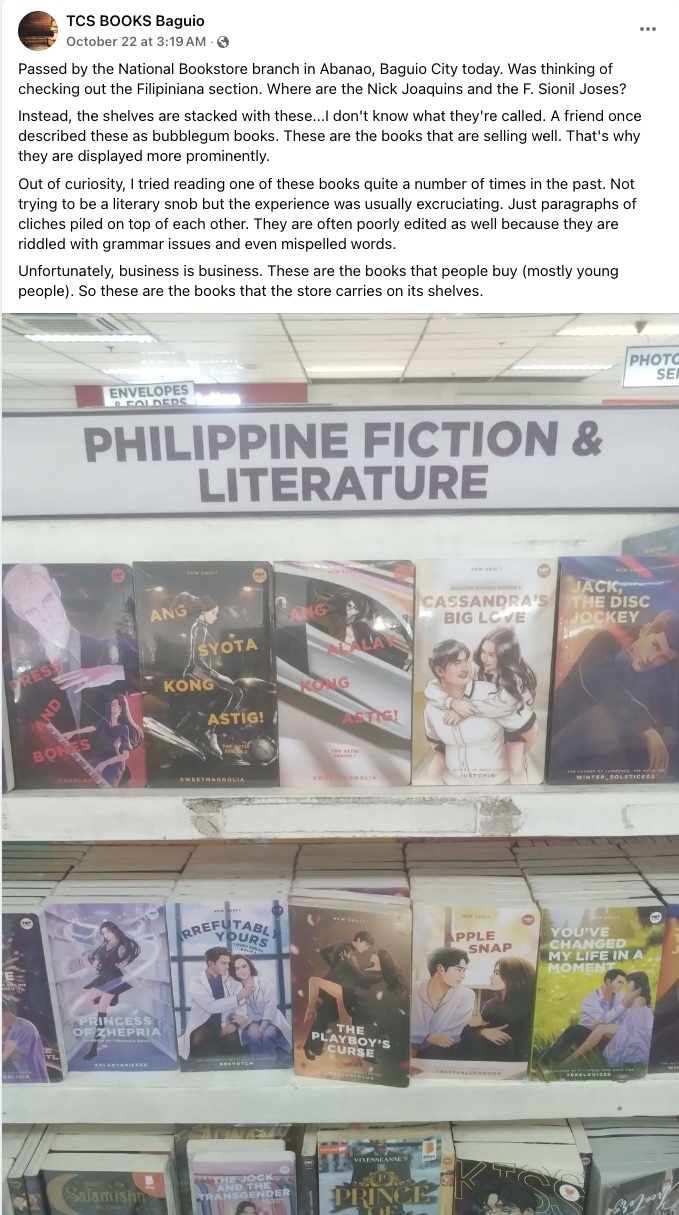A recent post about someone’s experience at a popular book store branch has sparked a heated discussion concerning the rich literary landscape of the Philippines and Filipinos’ consumption of it–or the lack thereof.
In a Facebook post, a reader, posting as a page, wanted to check out books from well-known writers like Nick Joaquin and F. Sionil Jose. The reader decided to explore the Filipiniana section of a popular book store in Baguio. Instead, the reader discovered that the shelves under this section are filled with what some call as “bubblegum books.”

These easy-to-read novels have taken center stage in bookstores, reflecting shifting consumer tastes and igniting an intriguing discussion about how literature is changing. Their popularity has sparked discussions about the place of these “bubblegum books” in contemporary reading culture.
Some critics of the post contend that these books lack the nuance and subtlety of traditional literature, yet others see their potential to appeal to a younger readership. Some recognize that these works, with their relevance to everyday life and their lighthearted nature, have a broad appeal. In a society where time is a luxury, the charm of a humorous read is undeniable. For many, these books are not just a pleasant diversion, but a gateway to a lifelong love of reading.
However, the debate over the enjoyment of popular literature versus the recognition of literary excellence has brought to light the accusations of literary elitism. Some argue that these accessible stories should not be dismissed, as they play a crucial role in introducing people to the world of literature.
Many point out that young readers find that “bubblegum books” offer more than just amusement; they also serve as a starting point for exploring more sophisticated literature. These books promote a variety of literary preferences and help nurture a new generation of voracious readers by creating a culture that values a wide range of reading materials.
This discussion also highlights how bookstores influence readers’ tastes in literature. Bookstores adapt to the needs of the market, and the popularity of popular fiction reflects shifting consumer preferences. Offering a wide range of categories broadens consumers’ choices and can enhance their reading experience by allowing them to discover a multitude of genres and styles, making reading an enjoyable habit.
While the classics created by writers like Joaquin and Jose are still treasured in our literary canon, the popularity of “bubblegum books” signifies an intriguing shift in reading habits. Allowing both forms to coexist in points of purchase encourages us to honor the diversity of voices and stories that readers can access.
The post also points to the changing ways Filipinos consume literature, highlighting the rising popularity of light and enjoyable reading. We can view this as an opportunity to introduce readers to a broader range of literature rather than as a decline in literary standards.
Ultimately, the definition of ‘good’ literature is a personal choice, and our literary culture is enriched by its diversity. By valuing both depth of thought and popular appeal, we can create a more inclusive reading environment that celebrates the joy of books in all their forms.
Filipinos can choose to embrace ‘bubblegum books’ alongside traditional classics and recognize the ways in which literature has transformed and evolved over time.
Other POP! stories you might like:
Social media users call out vlogger Rosmar Tan for ‘weird flex’ amid Kristine onslaught
TikTok user’s ‘hot take’ on Filipino food recommendation sparks debate on culinary identity
‘Receipt wars’ erupt between Heart Evangelista and Pia Wurtzbach camps over fashion show invite
‘End of an era?’ Some social media users think ‘BINI fever’ is nearing its end
‘Prince Charming’ in development, ‘Paddington’ and ‘Wonka’ director to lead project

